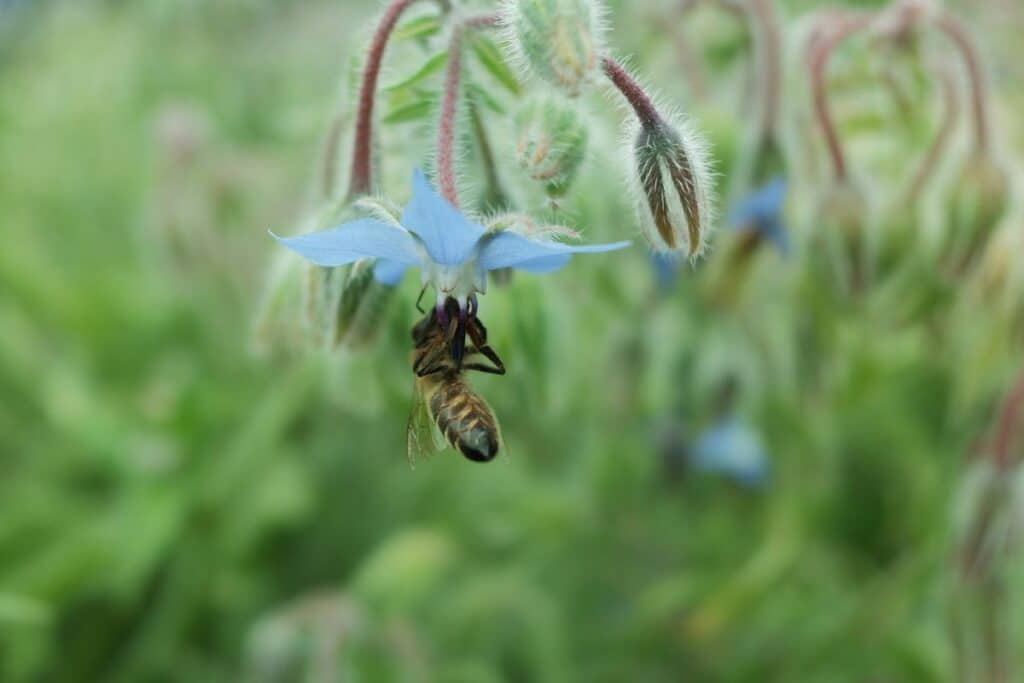Borage (Borago officinalis), often called starflower, are some of the best plants to add to your planting bed because they offer lots of great benefits.
These wonderful plants are helpful for attracting beneficial insects, they have many medicinal uses, promote the health of your soil, are very easy to grow and care for, and will benefit most other plants in your garden.
This edible plant is also very beautiful because it produces lots of delicate blue/lavender flowers that can add lots of color to your garden while borage leaves will add more texture and charm.
The best way to enjoy all of the benefits that borage has to offer is by pairing them with the correct companion plants. In this guide, we are going to take a look at some of the best borage companion plants to include in your garden.
What to Plant With Borage
When you are busy selecting the best companion plant varieties to grow with your healthy borage plants the first thing you should consider is growing needs. Companion planting is only successful if you select plants with the same growing requirements as borage.
Borage flowers can grow well in most soil types including nutrient-poor soils as long as it is well-drained soil. If you want lots of blooms then it is best to establish these florals in an area where they will receive lots of direct sunlight.
- Botanical name – Borago officinalis
- Height – 3 feet(91 centimeters) tall
- Colors – Blue flowers with green velvety foliage
- Bloom Season – Summer
- Pairing Benefits – Attract beneficial insects, aesthetic appeal, improve soil quality
Let’s explore some of the best plants to grow next to your borage plants if you want a healthy and vibrant garden.
Strawberries
Strawberries (Fragaria x ananassa) is an excellent companion plant to add to your borage garden because the borage will help protect your fruit yields and can boost the growth of your berry plants.
Strawberries are vulnerable to pests like weevils, spittlebugs, sap bugs, and many others. Borage is known to attract predatory insects that can feed on common strawberry pests and will keep these pests from devouring your plants and fruits.
Adding a couple of borage flowers to your plant bed will also attract pollinators that can increase the number of fruits these low-profile plants produce.
Borage will work wonders to replenish nutrients in the soil which can give other plants a boost during the growing season.
The vivid blue flowers will also create a striking effect when there are lots of vivid red berries peeking out all over the garden bed.
These two plants can easily be established in the same garden area because they both flourish in direct sunlight and need well-drained soil.
The only thing you need to keep in mind is that borage grows much taller with a maximum height of 3 feet. If your planting bed becomes overcrowded, the strawberries will be deprived of natural light. It is best to establish borage in a row behind your strawberries so both can enjoy plenty of sunlight.
- Botanical name – Fragaria x ananassa)
- Height – 6 – 8 Inches (15-20 centimeters)
- Colors – Red berries, white flowers, and vivid green foliage
- Flowering Season – Late summer and early fall
- Pairing Benefits – Higher strawberry yields, protection from pests, enhanced growth, and aesthetic appeal
Tomatoes
Not all gardeners believe that borage and tomatoes (Solanum Lycopersicum) can be grown together. There are, however, many who believe that these plants complement one another very well.
Borage plants naturally repel pests like tomato hornworms and aphids and will protect your vegetable patch from these invaders.
The vivid flowers will also attract pollinators that can help increase your tomato yields and borage will boost the soil nutrients so tomatoes can grow healthy and strong.
The blue flowers will also look very attractive alongside the vivid red of ripening tomatoes.
When you are pairing these plants, it is usually best to position borage in between tomato plants and to leave plenty of room so they can branch out. This way the borage can offer efficient protection and nutrients without competing too much for sunlight or space.
- Botanical name – Solanum Lycopersicum
- Height – 3 – 4 feet tall (91 – 120 centimeters) for stool varieties
- Colors – Vivid green foliage with white flowers and red fruits
- Blooming Season – One month after planting
- Pairing Benefits – Protect tomato crops, increase yields, promotes growth, and enhance aesthetics
Squash
You can grow all sorts of squash plant (Cucurbita) varieties like butternut, sugar pumpkin, zucchini, banana squash, or patty pans along with borage plants because the borage in your garden will help nurture and protect these vegetables.
Borage flowers will add lots of visual interest, especially when they bloom at the same time as pumpkins.
The flowers will also attract pollinators that can increase your pumpkin harvest and they will attract carnivorous insects that can feed on common squash pests. The scent of borage also deters common zucchini pests.
Borage plants will increase nutrients in your soil which will boost the growth of squash. A lot of people also believe that borage promotes the flavor or taste of pumpkins and many love to include starflowers in these vegetable dishes because they add a spicy aroma that can make squash taste even better.
Borage and squash have similar growing heights and both can become quite bushy. When you grow these plants together, it is best to interplant them in the same garden and to leave plenty of room (30 – 60 inches) for the hairy leaves and stems to grow. They can successfully grow in full sun in soil with lots of organic matter.
- Botanical name – Cucurbita
- Height – 1 – 3 feet tall (30 – 90 centimeters)
- Colors – Green foliage, yellow or white blooms, and fruits that range from green to vivid orange in shade
- Flowering Season – Late spring to early fall
- Pairing Benefits – Enhances taste, repels pests, increases yields, and aesthetic appeal
Cucumbers
Cucumbers (Cucumis sativus) aren’t seen with borage too often because both can grow vigorously and can start competing for space. This combination of plants can however offer great benefits if planted correctly.
Borage is known to attract lots of bumblebees that love to feed on common cucumber pests like cucumber beetles. This can protect your cucumber bed from these types of invaders and the flowers will also attract other pollinators that can increase your cucumber yields.
Cucumbers are nutrient-hungry plants that will grow robustly when you have borage in the same garden because the borage plants will add lots of nitrogen to the soil.
The star-shaped flowers are also a wonderful addition if you want to brighten up your plant bed.
The best way to grow borage and cucumbers together is by establishing borage plants on opposite edges of your rows with a few plants in between cucumber plants. You can plant borage seeds 1/4 to 1/2 inches deep and leave about 1 foot between different plants growing nearby. Alternatively, you can establish cucumbers in a row behind borage and save room by trellising the cucumbers.
- Botanical name – Cucumis sativus
- Height – 6 to 8 inches tall but can be taller when trellised
- Colors – Green foliage, green fruits, and yellow flowers
- Blooming Season – Summer
- Pairing Advantages – Protection for cucumbers, more minerals in the soil, enhanced fruit yields
Grapes
Vine plants like grapes (Vitis) tend to be nutrient-hungry because the root systems need to support a lot of growth above the ground level. If you are growing grapes then borage is a great addition to your garden because borage adds nutrients like nitrogen, potassium, calcium, and other trace minerals back to the soil which can boost the growth of your grapes.
The bushy borage will also act as a ground cover that keeps the soil moist and cool while the spiky leaves can help repel some pests. The starry blue flowers of the grown borage also benefit your grapes because they act as host plant that attracts lots of pollinators like bees to your garden and helps repel certain pests that can feed on your grapes.
To grow borage with grapes, you can sow the seeds directly into your vine garden bed. Borage seeds will sprout easily and the self-sown borage seedlings will grow quickly without too much maintenance requirement.
When planting borage, it is best to establish it between your grapes with the vines trellising in a row above the borage. When the vines are trellised there will be a lot more room for the borage to grow and develop.
- Botanical name – Vitis
- Height – 1 – 4 meters
- Colors – Green leaves, woody stems, and black or green/yellow fruits
- Flower Season – Late spring
- Pairing Advantages – Increase soil nutrients, act as ground cover, aid pollination, repel pests
What Not to Plant with Borage
Borage is excellent for companion planting with a huge variety of ornamental and vegetable plants. There are, however, some plant varieties that do not pair well with this star shaped flower because some plants can stunt the growth of your borage and others might not flourish if grown next to these culinary plants.
Let’s take a quick look at the worst companions for borage. Here’s what should not be planted with borage:
Fennel
Fennel (Foeniculum vulgare) is a perennial herb that doesn’t have many friends. In fact, the only plant that can probably survive next to fennel is dill. This is because fennel is known to stunt the growth of any plants you add to the same garden bed.
When you grow fennel in your borage bed, the borage will develop a lot slower and could even start to die out after some time. If you want to add fennel to your garden to repel some pests and diseases then it is best to grow fennel in a pot.
Non-Trellised Vines
Borage needs plenty of sunlight to thrive and can become overrun by overgrowth from vine plants that are not trellised.
Rapid-growing vine plants with large leaves like cucumbers and melons can grow too aggressively due to all the nutrients offered by borage but will eventually smother borage because the large leaves will deprive these hairy plants of sunlight.
If you are going to grow vine plants and borage together then it is very important to grow your vine plants on a trellis behind the borage.
Aside from fennel and non-trellised vines, borage can be grown with just about any other plant under the sun. This friendly plant only offers benefits and won’t have any negative impact on your garden at all.
FAQs
Can you plant marigolds and borage together?
Yes, you can plant marigolds and borage together. Marigolds can help repel pests like nematodes, while borage attracts beneficial insects like bees and pollinators.
Can you plant basil and borage together?
Yes, Basil and borage can also be planted together. Basil can enhance the flavor of nearby plants and may help deter certain pests, while borage attracts pollinators and can act as a companion plant.
Can you plant basil and borage together?
Yes, Borage and eggplant can be planted together. Borage can attract pollinators to the garden, which can benefit the eggplant’s fruit production. However, ensure that borage is not overcrowding the eggplant, as both plants require adequate space to grow properly.
Final Thoughts
Borage is a favorite plant in many ornamental and vegetable gardens because they are attractive, good for the soil, and offer so much assistance to other plants. You can pair these plants with all sorts of companions like berries, tomatoes, squash, cucumbers, grapes, and many other plants to establish a much healthier and more organic garden.
We hope that this guide helped you select the best plants for companion planting so your borage and other plants can flourish. If you are also growing other vegetables or ornamental plants then you should have a look at some of our other guides where you can find other helpful growing and plant care tips.
See more: What does borage flower symbolize?
*image by Wirestock/depositphotos







